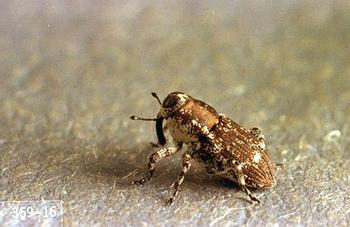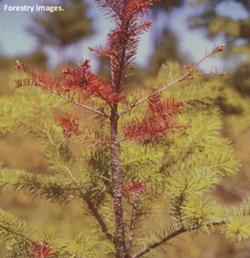Douglas-fir Twig Weevil (Cylindrocopturus furnissi)
Trees Affected


Common: Douglas-fir
Occasional: True firs
Summary
The Douglas-fir twig weevil is a 1/10” long weevil with a bronze body (sometimes with white spots) and a long beak. Both adults and larvae feed on their host tree, with adults feeding on needles and larvae feeding on twigs, small stems, and branches of their host tree. Adults are present year round, but are most obvious during the summer when they are reproducing. Larvae are also present all year, but are actively boring into twigs and branches from January into May. Although adults cause mild foliar damage in the form of feeding holes in leaves, larvae cause the most obvious damage by killing small terminal and lateral branches, often resulting in forked tops and atypical branch architecture. Additionally, larvae may trigger swelling or reddish-brown discoloration in the branch they are feeding on. Like other boring insects, these weevils may carry spores of fungal pathogens into the tree, which may subsequently contribute to the tree’s overall pathogen load.
Local Distribution


Unknown.
Management Strategies
As with many minor pests, trees are better able to withstand these weevils under less stressful growing conditions, so planting in and maintaining healthy stand conditions is helpful. If twig weevils do get established, removing infested trees and branches before new adults emerge in June can reduce future damage.
Pests and Pathogens with Similar Symptoms
Douglas-fir Pole Beetle (Pseudohylesinus nebulosus) or
Douglas-fir Engraver Beetle (Scolytus unispinosus): Terminal and lateral branch dieoff could look similar to a very minor infestation of either of these bark beetles, both of which may cause branch flagging or crown top dieoff. However, it is likely that the effects of either of these beetles would be somewhat more widespread within a tree. Additionally, both make galleries with multiple larval chambers on the main stem and large branches, while twig weevil larvae bore into twigs and small branches individually.
Further Reading
Description and additional management strategies for conifer weevils:
https://www.oregon.gov/ODF/Documents/ForestBenefits/Weevils_2017.pdf
